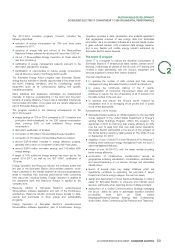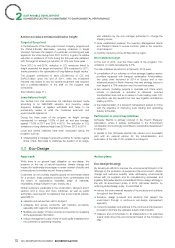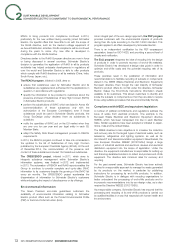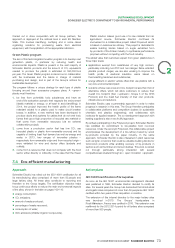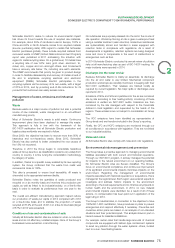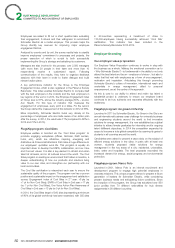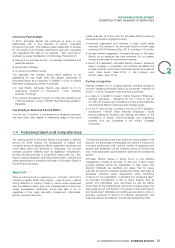APC 2014 Annual Report Download - page 77
Download and view the complete annual report
Please find page 77 of the 2014 APC annual report below. You can navigate through the pages in the report by either clicking on the pages listed below, or by using the keyword search tool below to find specific information within the annual report.
SUSTAINABLE DEVELOPMENT
SCHNEIDER ELECTRIC’S COMMITMENT TO ENVIRONMENTAL PERFORMANCE
Schneider Electric’s desire to reduce its environmental impact
No substances are purposely released into the soil in the course of
has driven its focus towards the use of recycled raw materials.
site operation. Workshop flooring at risk is given a waterproof seal
For example, about 85% of cardboard used in Europe, 100% in
using a suitable treatment (resin retention). Hazardous substances
China and 60% in North America comes from recycled material
are systematically stored and handled in areas equipped with
(source: purchasing data). With regard to metals that Schneider
retention tanks in compliance with regulations. As a result of
Electric purchases globally, these include recycled material from
developments in legislation, retention systems are being designed
recovered waste. A UNEP (United Nations Environment Program)
more and more to compensate in the event of malfunctions or
report was published in2011 addressing the situation with
emergencies, such as fires.
regard to metal recycling rates. On a global level, 18metals have
In2014 Schneider Electric conducted its annual review of pollution
a recycling rate of over 50%: lead, gold, silver, aluminum, tin,
risks at all manufacturing sites as part of ISO14001 tracking. No
nickel, zinc, copper and iron amongst others, and 34elements 2
major incidents were reported in2014.
have a recovery rate below 1%, including rare earth elements.
Discharge into the water and air
The UNEP recommends that priority be given to product design
in order to facilitate disassembly and recovery of metals at end of
Because Schneider Electric is mainly an assembler, its discharge
life and to emphasize recycling electrical and electronic
into the air and water is very limited. Mechanical component
equipment (WEEE). Schneider Electric participates in the
production workshops are carefully monitored, in keeping with their
recycling systems via the recovery of its own waste, with a target
ISO14001 certification. Their releases are tracked locally as
of 87% in2014, and by providing end-of-life instructions for its
required by current legislation. No major spills or discharges were
products that customers can easily access online.
reported in2014.
Management of waste, emissions and industrial
Emissions of NOx and SOx and particlesinto the air are monitored
site by site according to their heating activity; monitoring of these
pollution
emissions is verified via ISO14001 audits. Emissions are then
Waste
monitored by the site managers with respect to the thresholds
defined in local legislation and supervised by the heads of the
Because waste is a major source of pollution but also a potential regions. These emissions are not subject to consolidation at Group
source of raw materials, waste management is an eco-efficient level.
manufacturing priority.
The VOC emissions have been identified as representative of
Most of Schneider Electric’s waste is solid waste. Continuous Group levels and are therefore included in the Group’s reporting.
improvement plans have been deployed to manage this waste.
This approach is fully in line with the framework of the Finally, the CFC and HCFC emissions are monitored through our
ISO14001certification that all Schneider Electric production and air conditioners in accordance with legislation. They are not linked
logistics sites worldwide are required to follow. to our industrial activities.
Since 2009, the objective has been to recover more than 85% of
Noise and odors
hazardous and non-hazardous waste. Since 2012, Schneider All Schneider Electric sites comply with noise and odor regulations.
Electric has also worked to better understand the root causes of
the 15% not recovered.
Environmental risk management and prevention
Therefore, in 2013 the Group began to consolidate hazardous
The Group takes a proactive approach to managing environmental
waste at Group level but, as classification systems vary widely from
liabilities associated with both current and historical operations.
country to country, it is fine tuning the consolidation methodology
Through our ISO14001 program, it actively manages the potential
by category of waste.
for impacts to the natural environment at our operating facilities.
In addition, thanks to a specific survey enabled by its new reporting No Schneider Electric sites are Seveso classified. The Group’s
system, the Group confirmed that the waste from metal was focus on environmental compliance and continuous improvement
recovered at close to 100%. of its significant environmental impacts minimizes impacts on the
This data is processed to ensure local traceability. All waste is environment. Regarding the management of environmental
channeled to the appropriate treatment facility. impacts associated with historical operations or acquisitions, this is
managed at the regional level. Each region uses external experts to
Schneider Electric notes the quantities of waste produced and investigate and address historic impacts to the environment
recycled on a six monthly basis and monitors this production per according to the local requirements and to minimize any impacts to
capita, as well as linked to its industrial activity, on a like-for-like human health and the environment. In 2014, no new material
basis in order to evaluate its performance from one year to the environmental impacts were identified. As a result of all of these
next. actions, no compensation has been paid out in application of the
The overall eco-efficient manufacturing approach helped reduce legal ruling in2014.
our production of waste per capita in2014 compared with 2013 The Group’s industrial sites, in connection to the objective to have
on a like-for-like basis and to stabilize the proportion of waste 100% ISO 14001 certification, have procedures in place to prevent
recycled at 87.2% at the end of2014 on a like-for-like basis (target emergencies and respond effectively if necessary. Preventive and
of 87% in 2014 was exceeded). corrective action plans are based on an analysis of non-standard
Conditions of use and contamination of soils
situations and their potential impact. This analysis draws in part on
hazard reviews for classified installations.
Virtually all Schneider Electric sites are located in urban or industrial
areas and do not affect any notable biotopes. None of the Group’s For example, certain sites that handle large amounts of chemical
businesses involve extraction or land farming. compounds are equipped with balloon-type containment systems
to avoid any pollution through the water systems; others, located
next to a river, have floating beams.
75
2014 REGISTRATION DOCUMENT SCHNEIDER ELECTRIC






